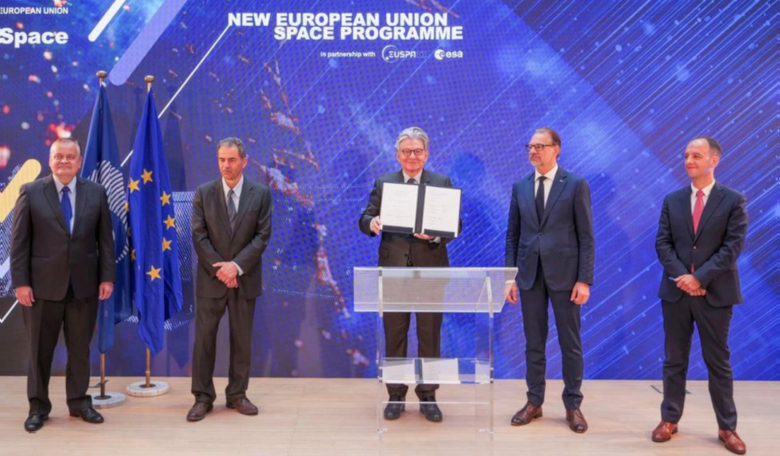After months of constructive negotiations, ESA and EU signed today a new Financial Framework Partnership Agreement (FFPA) in a ceremony to celebrate the launch of the new EU space programme.
This will mark a fresh start for space activities in Europe and represents an important step forward in the relationship between ESA and EU. It is also one of the top priorities of Agenda 2025, the roadmap of ESA’s Director General Josef Aschbacher.
“This is a major achievement for ESA, recognised for its scientific excellence and technical expertise in designing space systems and ground facilities for the benefit of European citizens,” said ESA Director General Josef Aschbacher.
“I’m grateful and would like to thank Commissioner Thierry Breton for the trust given to ESA, whose experience in all areas of space activities is rewarded here by an enhanced cooperation between our two institutions, bringing a new ambition for space in Europe.”
The new EU space programme will ensure the continuity and reinforces the very successful flagships such as Galileo, Copernicus and EGNOS, that were designed by ESA, and positioned Europe in a global leading role in the areas of Earth observation and navigation. It will also support new initiatives especially in the domain of secure connectivity, research and development and space commercialisation, where ESA will play a key role, also offering new funding opportunities for entrepreneurship.
The agreement signed today represents an EU investment of almost €9 billion in the period of 2021 to 2027, for ESA and European industry to design new-generation systems and programmes, crucial for the economy and a green and digital Europe. This funding adds to ESA’s budget and thus consolidates an ambitious set of mandatory and optional programmes, as defined by ESA Member States.
The FFPA agreement defines the roles and responsibilities of all partners, the European Commission, ESA and the new EU space programme agency, EUSPA. It will also ensure the level of autonomy of ESA that is necessary to efficiently develop and implement the programmes.
In the last two decades, ESA successfully developed Copernicus and the Galileo and EGNOS satellite navigation systems. Copernicus is a game changer and rapidly became, through its space component, the biggest provider of free and open Earth observation data in the world.
The FFPA will allow this flagship programme to be taken to the next level, strengthening ESA’s role as the architect of European Earth observation by developing and building the Sentinels Expansion missions and the Sentinel next generation missions, in order to respond to new emerging and urgent user needs and to guarantee enhanced continuity of current data. Such missions will monitor various aspects of climate change and will support the implementation of key EU policies, such as the Green Deal. This places Europe at the centre of the international space stage, reinforcing its leading role in tackling climate change, monitoring biodiversity and supporting disaster relief.
Galileo is Europe’s civil global satellite navigation constellation and a major success, being currently the world’s most precise satnav system and offering metre-scale accuracy to more than two billion users around the globe.
The FFPA will bring Galileo to the next level with the development of the second generation, a further step forward with the use of many innovative technologies to guarantee unprecedented precision, robustness and flexibility of the system. This will boost European economy with the perspective for many new devices and services to offer positioning capabilities, a true revolution for emerging self-driving cars, autonomous drones and the whole ‘Internet of things’. EGNOS is the world’s most advanced Satellite-Based Augmentation Systems (SBAS), offering unprecedented, guaranteed position accuracy, not only to the aviation sector but also to other transport and agricultural sectors.
The FFPA agreement includes additional components under ESA’s responsibility, such as the preparation and design of the future GOVSATCOM space segment and validation of a prototype for Quantum Key Distribution satellite in support to the new EU flagship on secure connectivity, In-Orbit demonstration/Validation service and space safety activities to monitor space hazards.
The FFPA agreement includes additional components under ESA’s responsibility, such as the preparation and design of new flagship secure connectivity GOVSATCOM programme, In-Orbit demonstration/Validation service and space safety activities to monitor space hazards.
ESA is the European Space Agency and Europe’s gateway to space. Its mission is to shape the development of Europe’s space capability and ensure that investment in space continues to deliver benefits to the citizens of Europe and the world. With 22 Members States, ESA is an intergovernmental organisation working closely with European industry, national space agencies and the European Union, as well as cooperating with space agencies worldwide.
ESA covers a wide range of activities, including launchers, science, robotic and human exploration, navigation, Earth observation, telecommunications, space safety and operations. It designs, builds and operates facilities and a fleet of space missions in orbit around the Earth and in the Solar System, and flies European astronauts with international partners.











